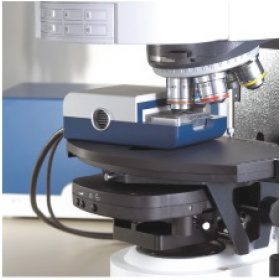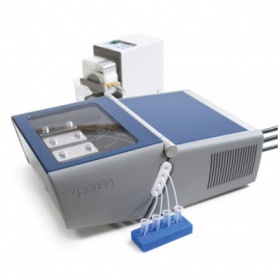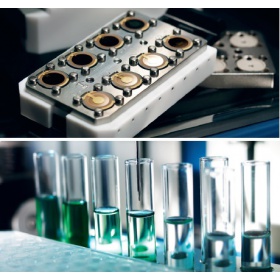-
产品文章
-
百欧林简报-表界面科学Zxin文献- QSense -2019年
发布:瑞典百欧林科技有限公司浏览次数:674百欧林简报-表界面科学Zxin文献- QSense -2019年第16期
1. Name:Layer by Layer Antimicrobial Coatings Based on Nafion, Lysozyme, and Chitosan
Authors:Ella N. Gibbons, Charis Winder, Elliot Barron, Diogo Fernandes, Marta J. Krysmann, Antonios Kelarakis, Adam V. S. Parry and Stephen G. Yeates
Journal:Nanomaterials
DOI: 10.3390/nano9111563
Abstract:The study focuses on the development of a new family of layer-by-layer coatings comprising Nafion, lysozyme and chitosan to address challenges related to microbial contamination. Circular dichroism was employed to gain insights on the interactions of the building blocks at the molecular level. Quartz crystal microbalance tests were used to monitor in real time the build-up of multilayer coatings, while atomic force microscopy, contact angle and surface zeta potential measurements were performed to assess the surface characteristics of the multilayer assemblies. Remarkably, the nanocoated surfaces show almost 1**% reduction in the population of both Escherichia coli and Staphylococcus aureus. The study suggests that Nafion based synergistic platforms can offer an effective line of defence against bacteria, facilitating antimicrobial mechanisms that go beyond the concept of exclusion zone.
Link:https://www_mdpi.xilesou.top/2079-4991/9/11/1563
2. Name:Clickable poly-l-lysine for the formation of biorecognition surfaces
Authors:Daniele Di Iorio, Almudena Marti, Sander Koeman and Jurriaan Huskens
Journal:RSC Advances
DOI: 10.1039/c9ra08714a
Abstract:Biomolecules are immobilized onto surfaces employing the fast and stable adsorption of poly-L-lysine (PLL) polymers and the versatile copper-free click chemistry reactions. This method provides the combined advantages of versatile surface adsorption with density control using polyelectrolytes and of the covalent and orthogonal immobilization of biomolecules with higher reaction rates and improved yields of click chemistry. Using DNA attachment as a proof of concept, control over the DNA probe density and applicability in electrochemical detection are presented.
Link:https://pubs.rsc.org/en/content/articlelanding/2019/ra/c9ra08714a#!divAbstract
3. Name:An ultrafast quartz crystal microbalance based on a frequency comb approach delivers sub-millisecond time resolution
Authors:Frederick Meyer, Arne Langhoff, Antonio Arnau, Diethelm Johannsmann and Ilya Reviakine
Journal:Review of Scientific Instruments
DOI: 10.1063/1.5115979
Abstract:Quartz crystal microbalance with dissipation monitoring (QCMD) is a simple and versatile sensing technique with applications in a wide variety of academic and industrial fields, most notably electrochemistry, biophysics, quality control, and environmental monitoring. QCMD is limited by a relatively poor time resolution, which is of the order of seconds with conventional instrument designs at the noise level usually required. In this work, we present a design of an ultrafast QCMD with submillisecond time resolution. It is based on a frequency comb approach applied to a high-fundamental-frequency (HFF) resonator through a multifrequency lock-in amplifier. The combination allows us to reach data acquisition rates >10 kHz. We illustrate the method using a toy model of a glass sphere dropped on the resonator surfaces, bare or coated with liposomes, in liquid. We discuss some interesting features of the results obtained with the dropped spheres, such as bending of the HFF resonators due to the impact, sphere bouncing (or the absence of it), and contact aging.
Link:https://aip_scitation.xilesou.top/doi/abs/10.1063/1.5115979
4. Name:Unvei领 the multi-step solubilization mechanism of sub-micron size vesicles by detergents
Authors:Paul A. Dalgarno, José Juan-Colás, Gordon J. Hedley, Lucas Piñeiro, Mercedes Novo, Cibran Perez-Gonzalez, Ifor D. W. Samuel, Mark C. Leake, Steven Johnson, Wa极h Al-Soufi, J. Carlos Penedo and Steven D. Quinn
Journal:Scientific Reports
DOI: 10.1038/s41598-019-49210-0
Abstract:The solubilization of membranes by detergents is critical for many technological applications and has become widely used in biochemistry research to induce cell rupture, extract cell constituents, and to purify, reconstitute and crystallize membrane proteins. The thermodynamic details of solubilization have been extensively investigated, but the kinetic aspects remain poorly understood. Here we used a combination of single-vesicle Förster resonance energy transfer (svFRET), fluorescence correlation spectroscopy and quartz-crystal microbalance with dissipation monitoring to access the real-time kinetics and elementary solubilization steps of sub-micron sized vesicles, which are inaccessible by conventional diffraction-limited optical methods. Real-time injection of a non-ionic detergent, Triton X, induced biphasic solubilization kinetics of surface-immobilized vesicles labelled with the Dil/DiD FRET pair. The nanoscale sensitivity accessible by svFRET allowed us to unambiguously assign each kinetic step to distortions of the vesicle structure comprising an initial fast vesicle-swel领 event followed by slow lipid loss and micellization. We expect the svFRET platform to be applicable beyond the sub-micron sizes studied here and become a unique tool to unravel the complex kinetics of detergent-lipid interactions.
Link:https://www.nature.com/articles/s41598-019-49210-0
5. Name:A fundamental study of adsorption kinetics of surfactants onto metal oxides using quartz crystal microbalance with dissipation (QCM-D)
Authors: Sandra C.Medina, Andreia S.F.Farinha, Abdul-Hamid Emwas, Assiyeh Tabatabai and TorOve Leiknes
Journal:Colloids and Surfaces A: Physicochemical and Engineering Aspects
DOI: 10.1016/j.colsurfa.2019.124237
Abstract:Membrane fou领 challenges the viability of oil-field produced water (PW) treatment with ceramic membranes. Surfactants play an important role in irreversible fou领 through adsorption phenomena. However, previous studies have shown contradictory results. Hence, a fundamental understanding of surfactants-metal oxides interactions is necessary.
Link:https://www.sciencedirect.com/science/article/pii/S0927775719312324
6. Name:Understanding the cation dependent surfactant adsorption on clay minerals in oil recovery
Authors: Zilong LiuZilong Liu, Murali K. Ghatkesar, Ernst J. R. Sudholter, Binder Singh and Naveen Kumar
Journal:Energy & Fuels
DOI: 10.1021/acs.energyfuels.9b03109
Abstract:Surfactants have the ability to mobilize residual oil trapped in pore spaces of matrix rocks by lowering the oil-water interfacial tension, resulting in a higher oil recovery. However, the loss of surfactant by adsorption onto the rock surface has become a major concern that reduces the efficiency of the surfactant flooding process. In this study, the adsorption behavior of an anionic surfactant to a clay mineral surface was investigated by Quartz Crystal Microbalance with Dissipation monitoring (QCM-D) upon variation with different cation conditions. Through recording the change of frequency and dissipation of clay modified sensors, it allows us for a real-time quantitative analysis of the surfactant adsorption with nanogram sensitivity. The results revealed that the surfactant adsorption increased in a Ca2+ containing solution with increasing pH from 6 to 11, while from a Na+ containing solution more adsorption occurred at acidic conditions. The adsorbed amount went through a maximum (~200 mM) as a function of the Ca2+ concentration and the Voigt model suggested that multilayer adsorption of surfactants could be as many as 4-6 monolayers. Using mixed cation (Ca2+ and Na+) solutions, the amount of adsorbed surfactant decreased linearly with decreasing fraction of CaCl2, but Na+ competed for about ~30% adsorption sites. The importance of the presence of CaCl2 for the surfactant adsorption was stressed in high salinity and low salinity solutions in the presence and absence of Ca2+. Furthermore, increasing the temperature from 23 to 65 °C shows first a small increase of surfactant adsorption followed by a reduction about 20%. The obtained results contribute to a better understanding of surfactant adsorption on clay surfaces and guide to optimal flooding conditions with a reduced surfactant loss.
Link:https://pubs.acs.org/doi/10.1021/acs.energyfuels.9b03109
2019-12-04相关仪器 -
免责声明
①本网刊载上述内容,并不代表本网赞同其观点或证实其内容的真实性,不承担此类作品侵权行为的直接责任及连带责任
②若本站内容侵犯到您的合法权益,请及时告诉,我们马上修改或删除。邮箱:hezou_yiqi

-
 认证会员 第
3 年
认证会员 第
3 年佰奥林(上海)贸易有限公司
认证:工商信息已核实
- 产品分类
- 品牌分类
-
仪企号
 瑞典百欧林科技有限公司上海代表处
瑞典百欧林科技有限公司上海代表处
-
友情链接
-
手机版开启全新的世界m.yiqi.com/zt3047/









